Astrometa DVB-T2: Difference between revisions
Narcisgarcia (talk | contribs) |
|||
| (15 intermediate revisions by 5 users not shown) | |||
| Line 6: | Line 6: | ||
==Components== |
==Components== |
||
The device was usually shipped with these components: |
|||
*USB interface: [[RealTek RTL2832U|Realtek RTL2832P]] |
*USB interface: [[RealTek RTL2832U|Realtek RTL2832P]] |
||
*Demodulator: Panasonic MN88473 (2013 revision: [[Panasonic MN88472|MN88472]]) |
*Demodulator: Panasonic MN88473 (2013 revision: [[Panasonic MN88472|MN88472]]) (2018 revision: [[Sony CXD2841|Sony CXD2837ER]]) |
||
*Tuner: Rafael Micro R828D (TVR801: R820T) |
*Tuner: Rafael Micro R828D (TVR801: R820T) |
||
The USB interface bridge for all devices are supported by rtl238xx driver. All tuners are supported by the same driver (rt820t). The demulator driver varies from version to version: it can be mn88472, mn88473 or cxd2841er. |
|||
The different revisions of the Astrometa DVB-T2 have been released under many different "brand" names. This page cannot list all of them. If you buy a new tuner from an unknown or no brand for under 30 euros or so, you will probably get some Astrometa clone. |
The different revisions of the Astrometa DVB-T2 have been released under many different "brand" names. This page cannot list all of them. If you buy a new tuner from an unknown or no brand for under 30 euros or so, you will probably get some Astrometa clone. |
||
2013 and 2014 revision look very similar. Probably, the text on the 2013 revision always reads "FM+DAB+SDR", while the 2014 one says "DVB-T/T2/C+FM+DAB". However, seller pictures do not always reflect that change and one could end up buying a random version even years later. |
'''2013''' and 2014 revision look very similar. Probably, the text on the 2013 revision always reads "FM+DAB+SDR", while the 2014 one says "DVB-T/T2/C+FM+DAB". However, seller pictures do not always reflect that change and one could end up buying a random version even years later. |
||
The 2014 revision version is also sold as "Andoer Digital DVBT2 USB TV Stick" or "Docooler YRC1415458446568TZ". Those devices are identical in appearance to the usual Astrometa devices. |
The '''2014''' revision version is also sold as "Andoer Digital DVBT2 USB TV Stick" or "Docooler YRC1415458446568TZ". Those devices are identical in appearance to the usual Astrometa devices. |
||
[[TeVii]] sells a similar device under the name "H630". The case is black. The PCB layout is a bit different, e.g. the IR sensor is in a different position. |
[[TeVii]] sells a similar device under the name "H630". The case is black. The PCB layout is a bit different, e.g. the IR sensor is in a different position. |
||
| Line 21: | Line 23: | ||
There is a version of the device called TVR801, which uses an unlabelled Rafael Micro R820T tuner. According to official sources, this one does not support DVB-C. |
There is a version of the device called TVR801, which uses an unlabelled Rafael Micro R820T tuner. According to official sources, this one does not support DVB-C. |
||
| ⚫ | |||
| ⚫ | In 2017, a clone of the 2014 version with a red PCB (original Astrometa one's is green) also appeared on E-commerce sites that ship from China. The case looks like the H630's, but is white with silver text that reads "DVB-T/T2/C/FM/DAB". This device is shipped in bulk in just a plastic bag with a simple stick antenna, a remote control (21 buttons) and a Mini CD that dates to 09 Jan 2017. Some sellers call it OXA ZC905500 or S SKYEE. It is also sold under the name "iViewHD" inside the case of the TVR801 |
||
| ⚫ | In '''2017''', a clone of the 2014 version with a red PCB (original Astrometa one's is green) also appeared on E-commerce sites that ship from China. The case looks like the H630's, but is white with silver text that reads "DVB-T/T2/C/FM/DAB". This device is shipped in bulk in just a plastic bag with a simple stick antenna, a remote control (21 buttons) and a Mini CD that dates to 09 Jan 2017. Some sellers call it OXA ZC905500 or S SKYEE. It is also sold under the name "iViewHD" inside the case of the TVR801 and its antenna has an USB-powered amplifier. '''See 2018 update below!''' |
||
In ''2018'' several clones are being shipped using the Sony CXD2837 chipset. This has a [https://github.com/torvalds/linux/commit/381a28be485f66e70c5296963caf9c116bdef42c driver from kernel 4.14] onwards (it is now covered by the cxd2841er driver), but the device as a whole does not work because the RTL2832 driver has not been updated to recognise it. However, updated RTL2832 driver has been accepted to the [https://git.linuxtv.org/media_tree.git/commit/?id=d695eb5b3b963230652db29eae341a9706c593f4 media_tree] (as mentioned [https://github.com/torvalds/linux/pull/567#issuecomment-449709791 here]) so you can compile it yourself (see [[How to Obtain, Build and Install V4L-DVB Device Drivers#Retrieving_from_the_upstream_development_Kernel_tree]]) or use a specialized distribution such as LibreELEC (kodi appliance) which supports this device out-of-the-box, provided you enable the bundled "DVB drivers from the latest kernel (media_build)" add-on. These changes will most likely be included in the next mainline kernel. In most cases the RTL chip does not appear to be connected to the tuner, so these devices will not work for DVB-T either. Even though the chipset is different and incompatible, the same USB vendor and product IDs are used (15f4:0131). The clones with the Sony demodulator reported so far are: |
|||
In 2018 the aforementioned clone with the silver text has been modified to use the Sony CXD2837 chipset for DVB-T2, for which a [https://forum.turris.cz/t/dvb-t2-tuner-for-omnia/1564/27 driver is not in the mainline Linux kernel]. Even though the chipset is different and incompatible, the same USB vendor and product IDs are used (15f4:0131). The PCB color is blue. The out-of-tree driver [https://github.com/DigitalDevices/dddvb/blob/master/frontends/cxd2843.c "cxd2843.ko"] supposedly works for this chip. [https://pastebin.com/hWpNk5Zn dmesg output], [https://pastebin.com/Q1yhkGxj lsusb -vvv output] and [https://imgur.com/a/dZrKs PCB fotos here]. Another version of the Sony revision has said text on the bottom side of its black case, while the top side reads "Auzeuner". If in doubt, you (or a potential seller) can easily hold it in front of (or for the black ones: directly under) a light source and see the color of the PCB through the holes. |
|||
* Blue coloured PCB either with a white case or a black case, both with silver writing. You (or a potential seller) can tell if this uses an incompatible Sony chip by holding it in front of (or for the black ones: directly under) a light source and see the colour of the PCB through the holes. [https://pastebin.com/hWpNk5Zn dmesg output], [https://pastebin.com/Q1yhkGxj lsusb -vvv output] and [https://imgur.com/a/dZrKs PCB photos here] |
|||
* Green coloured PCB with a case matching the 2014 revision. The only way to tell if this uses the Sony chip (or is the 2014 revision with working Panasonic chipset) is to open the case and read the part number on the chip. |
|||
All these models share the same USB IDs. |
All these models share the same USB IDs. |
||
In '''2020''' Sam Nazarko Trading Ltd sells "[https://osmc.tv/store/product/tv-dongle/ DVB-T2/DVB-C TV dongle]" for OSMC supported devices, but it works with most of GNU/Linux platforms. This tuner is detected as same USB ID 15f4:0131 |
|||
| ⚫ | |||
{| class="wikitable" |
{| class="wikitable" |
||
| Line 37: | Line 44: | ||
| [[File:Astrometa TVR801.jpg|200px]]<br />(case also used for other revisions<br />or devices, often without the text) |
| [[File:Astrometa TVR801.jpg|200px]]<br />(case also used for other revisions<br />or devices, often without the text) |
||
| [[File:Astrometa 2017.jpg|200px]] |
| [[File:Astrometa 2017.jpg|200px]] |
||
| [[File:Astrometa 2018.jpg|200px]]<br />or same as 2017 revision |
| [[File:Astrometa 2018.jpg|200px]]<br />or same as 2014 or 2017 revision |
||
| [[File:Astrometa Analog.jpg|200px]] |
| [[File:Astrometa Analog.jpg|200px]] |
||
|- |
|- |
||
| Line 77: | Line 84: | ||
| '''Rafael Micro R820T'''<br />(probably doesn't support DVB-C) |
| '''Rafael Micro R820T'''<br />(probably doesn't support DVB-C) |
||
| Rafael Micro R828D |
| Rafael Micro R828D |
||
| Rafael Micro R828D or <br /> '''AT628''' (same as R828D) |
|||
| '''unknown'''<br />628 10504 102017 |
|||
| Rafael Micro R828D |
| Rafael Micro R828D |
||
|- |
|- |
||
| Line 93: | Line 100: | ||
| most likely |
| most likely |
||
| yes |
| yes |
||
| most likely since 5.0 |
|||
| unknown |
|||
| yes, since 4.14 |
|||
| unknown |
|||
|} |
|} |
||
PCBs of TVR801 and 2017 revision have the same color, the difference on the pictures comes from different lighting. There is another rare version described in [http://blog.palosaari.fi/2014/09/naked-hardware-18-astrometa-amdvb-t2-v2.html Antti's blog], which |
PCBs of TVR801 and 2017 revision have the same color, the difference on the pictures comes from different lighting. There is another rare version described in [http://blog.palosaari.fi/2014/09/naked-hardware-18-astrometa-amdvb-t2-v2.html Antti's blog], which pretty much the 2017 revision with a green PCB (and has some very little differences). |
||
==RTL2832P configuration== |
==RTL2832P configuration== |
||
Latest revision as of 06:50, 25 August 2020
This device is commonly found on E-commerce sites that ship directly from China. The hardware supports DVB-C, DVB-T and DVB-T2.
Support
DVB-T supported since kernel 3.13, DVB-T2 since 4.6. Drivers being developed support DVB-C with 64QAM/128QAM, but not 256QAM.
Components
The device was usually shipped with these components:
- USB interface: Realtek RTL2832P
- Demodulator: Panasonic MN88473 (2013 revision: MN88472) (2018 revision: Sony CXD2837ER)
- Tuner: Rafael Micro R828D (TVR801: R820T)
The USB interface bridge for all devices are supported by rtl238xx driver. All tuners are supported by the same driver (rt820t). The demulator driver varies from version to version: it can be mn88472, mn88473 or cxd2841er.
The different revisions of the Astrometa DVB-T2 have been released under many different "brand" names. This page cannot list all of them. If you buy a new tuner from an unknown or no brand for under 30 euros or so, you will probably get some Astrometa clone.
2013 and 2014 revision look very similar. Probably, the text on the 2013 revision always reads "FM+DAB+SDR", while the 2014 one says "DVB-T/T2/C+FM+DAB". However, seller pictures do not always reflect that change and one could end up buying a random version even years later.
The 2014 revision version is also sold as "Andoer Digital DVBT2 USB TV Stick" or "Docooler YRC1415458446568TZ". Those devices are identical in appearance to the usual Astrometa devices.
TeVii sells a similar device under the name "H630". The case is black. The PCB layout is a bit different, e.g. the IR sensor is in a different position.
There is a version of the device called TVR801, which uses an unlabelled Rafael Micro R820T tuner. According to official sources, this one does not support DVB-C.
In late 2015, a version with analog video input and analog tuning capabilities was released, powered by the Conexant CX23102-11Z USB bridge. It has a different device ID (0135) and is a different device. Support is unknown.
In 2017, a clone of the 2014 version with a red PCB (original Astrometa one's is green) also appeared on E-commerce sites that ship from China. The case looks like the H630's, but is white with silver text that reads "DVB-T/T2/C/FM/DAB". This device is shipped in bulk in just a plastic bag with a simple stick antenna, a remote control (21 buttons) and a Mini CD that dates to 09 Jan 2017. Some sellers call it OXA ZC905500 or S SKYEE. It is also sold under the name "iViewHD" inside the case of the TVR801 and its antenna has an USB-powered amplifier. See 2018 update below!
In 2018 several clones are being shipped using the Sony CXD2837 chipset. This has a driver from kernel 4.14 onwards (it is now covered by the cxd2841er driver), but the device as a whole does not work because the RTL2832 driver has not been updated to recognise it. However, updated RTL2832 driver has been accepted to the media_tree (as mentioned here) so you can compile it yourself (see How to Obtain, Build and Install V4L-DVB Device Drivers#Retrieving_from_the_upstream_development_Kernel_tree) or use a specialized distribution such as LibreELEC (kodi appliance) which supports this device out-of-the-box, provided you enable the bundled "DVB drivers from the latest kernel (media_build)" add-on. These changes will most likely be included in the next mainline kernel. In most cases the RTL chip does not appear to be connected to the tuner, so these devices will not work for DVB-T either. Even though the chipset is different and incompatible, the same USB vendor and product IDs are used (15f4:0131). The clones with the Sony demodulator reported so far are:
- Blue coloured PCB either with a white case or a black case, both with silver writing. You (or a potential seller) can tell if this uses an incompatible Sony chip by holding it in front of (or for the black ones: directly under) a light source and see the colour of the PCB through the holes. dmesg output, lsusb -vvv output and PCB photos here
- Green coloured PCB with a case matching the 2014 revision. The only way to tell if this uses the Sony chip (or is the 2014 revision with working Panasonic chipset) is to open the case and read the part number on the chip.
All these models share the same USB IDs.
In 2020 Sam Nazarko Trading Ltd sells "DVB-T2/DVB-C TV dongle" for OSMC supported devices, but it works with most of GNU/Linux platforms. This tuner is detected as same USB ID 15f4:0131
| 2013 revision | 2014 revision | TVR801 | 2017 revision | 2018 revision | 2015 revision: DVB+Analog TV | |
|---|---|---|---|---|---|---|
| Sample promo shot |
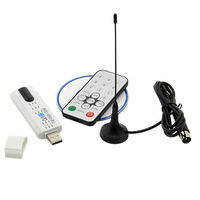 (some may look like the 2014 revision) |
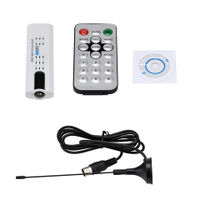 (some may look like the 2013 revision) |
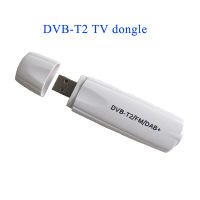 (case also used for other revisions or devices, often without the text) |
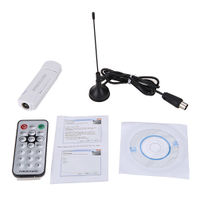
|
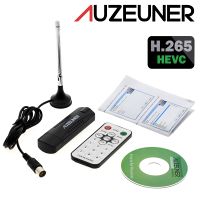 or same as 2014 or 2017 revision |
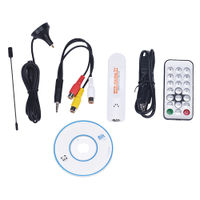
|
| Bottom PCB | same as 2014 revision (different demod, no number 1422) |
 ("1422" and text missing sometimes) |

|

|

|

|
| Top PCB | same as 2014 revision | 
|

|

|

|

|
| USB Bridge | Realtek RTL2832P | Realtek RTL2832P | Realtek RTL2832P | Realtek RTL2832P | Realtek RTL2832P | Conexant CX23102-11Z |
| Demod | Panasonic MN88472 (said to not support DVB-T2 v1.3.1, which is used in e.g. Germany) |
Panasonic MN88473 | Panasonic MN88473 | Panasonic MN88473 | Sony CXD2837ER | Panasonic MN88473 |
| Tuner | Rafael Micro R828D | Rafael Micro R828D | Rafael Micro R820T (probably doesn't support DVB-C) |
Rafael Micro R828D | Rafael Micro R828D or AT628 (same as R828D) |
Rafael Micro R828D |
| USB IDs | 15f4:0131 (Hanftek) | 15f4:0131 (Hanftek) | 15f4:0131 (Hanftek) | 15f4:0131 (Hanftek) | 15f4:0131 (Hanftek) | 15f4:0135 (Hanftek) |
| Supported | yes | yes | most likely | yes | most likely since 5.0 | yes, since 4.14 |
PCBs of TVR801 and 2017 revision have the same color, the difference on the pictures comes from different lighting. There is another rare version described in Antti's blog, which pretty much the 2017 revision with a green PCB (and has some very little differences).
RTL2832P configuration
The RTL2832P has 2 PID filter paths. One for the internal demod and one for a possible external one.
External ts mode
0x21[3] enable_ETS, set to enable external ts input 0x21[5] pass_err, when set reject error packets 0x21[6] PID_mode, when set reject matched PIDs 0x21[7] PID_output, when set output data from enabled PID filters 0x22[7-0] PID_enable, when set enable PID in corresponding register (0-7) 0x23[7-0] PID_enable, when set enable PID in corresponding register (8-15) 0x24[7-0] PID_enable, when set enable PID in corresponding register (16-23) 0x25[7-0] PID_enable, when set enable PID in corresponding register (24-31) 0x26-0x27[12-0] PID_0, PID storage register 13 bits wide 0x28-0x29[12-0] PID_1, PID storage register 13 bits wide 0x2A-0x2B[12-0] PID_2, PID storage register 13 bits wide 0x2C-0x2D[12-0] PID_3, PID storage register 13 bits wide 0x2E-0x2F[12-0] PID_4, PID storage register 13 bits wide 0x30-0x31[12-0] PID_5, PID storage register 13 bits wide 0x32-0x33[12-0] PID_6, PID storage register 13 bits wide 0x34-0x35[12-0] PID_7, PID storage register 13 bits wide 0x36-0x37[12-0] PID_8, PID storage register 13 bits wide 0x38-0x39[12-0] PID_9, PID storage register 13 bits wide 0x3A-0x3B[12-0] PID_10, PID storage register 13 bits wide 0x3C-0x3D[12-0] PID_11, PID storage register 13 bits wide 0x3E-0x3F[12-0] PID_12, PID storage register 13 bits wide 0x40-0x41[12-0] PID_13, PID storage register 13 bits wide 0x42-0x43[12-0] PID_14, PID storage register 13 bits wide 0x44-0x45[12-0] PID_15, PID storage register 13 bits wide 0x46-0x47[12-0] PID_16, PID storage register 13 bits wide 0x48-0x49[12-0] PID_17, PID storage register 13 bits wide 0x4A-0x4B[12-0] PID_18, PID storage register 13 bits wide 0x4C-0x4D[12-0] PID_19, PID storage register 13 bits wide 0x4E-0x4F[12-0] PID_20, PID storage register 13 bits wide 0x50-0x51[12-0] PID_21, PID storage register 13 bits wide 0x52-0x53[12-0] PID_22, PID storage register 13 bits wide 0x54-0x55[12-0] PID_23, PID storage register 13 bits wide 0x56-0x57[12-0] PID_24, PID storage register 13 bits wide 0x58-0x59[12-0] PID_25, PID storage register 13 bits wide 0x5A-0x5B[12-0] PID_26, PID storage register 13 bits wide 0x5C-0x5D[12-0] PID_27, PID storage register 13 bits wide 0x5E-0x5F[12-0] PID_28, PID storage register 13 bits wide These filters would overlap with the internal ts address space. 0x60-0x61[12-0] PID_29, PID storage register 13 bits wide 0x62-0x63[12-0] PID_30, PID storage register 13 bits wide 0x64-0x65[12-0] PID_31, PID storage register 13 bits wide Most likely the the external PID filter path has less then 32 pid filters.
Internal ts mode
0x61[5] pass_err, when set reject error packets 0x61[6] PID_mode, when set reject matched PIDs 0x61[7] PID_output, when set output data from enabled PID filters 0x62[7-0] PID_enable, when set enable PID in corresponding register (0-7) 0x63[7-0] PID_enable, when set enable PID in corresponding register (8-15) 0x64[7-0] PID_enable, when set enable PID in corresponding register (16-23) 0x65[7-0] PID_enable, when set enable PID in corresponding register (24-31) 0x66-0x67[12-0] PID_0, PID storage register 13 bits wide 0x68-0x69[12-0] PID_1, PID storage register 13 bits wide 0x6A-0x6B[12-0] PID_2, PID storage register 13 bits wide 0x6C-0x6D[12-0] PID_3, PID storage register 13 bits wide 0x6E-0x6F[12-0] PID_4, PID storage register 13 bits wide 0x70-0x71[12-0] PID_5, PID storage register 13 bits wide 0x72-0x73[12-0] PID_6, PID storage register 13 bits wide 0x74-0x75[12-0] PID_7, PID storage register 13 bits wide 0x76-0x77[12-0] PID_8, PID storage register 13 bits wide 0x78-0x79[12-0] PID_9, PID storage register 13 bits wide 0x7A-0x7B[12-0] PID_10, PID storage register 13 bits wide 0x7C-0x7D[12-0] PID_11, PID storage register 13 bits wide 0x7E-0x7F[12-0] PID_12, PID storage register 13 bits wide 0x80-0x81[12-0] PID_13, PID storage register 13 bits wide 0x82-0x83[12-0] PID_14, PID storage register 13 bits wide 0x84-0x85[12-0] PID_15, PID storage register 13 bits wide 0x86-0x87[12-0] PID_16, PID storage register 13 bits wide 0x88-0x89[12-0] PID_17, PID storage register 13 bits wide 0x8A-0x8B[12-0] PID_18, PID storage register 13 bits wide 0x8C-0x8D[12-0] PID_19, PID storage register 13 bits wide 0x8E-0x8F[12-0] PID_20, PID storage register 13 bits wide 0x90-0x91[12-0] PID_21, PID storage register 13 bits wide 0x92-0x93[12-0] PID_22, PID storage register 13 bits wide 0x94-0x95[12-0] PID_23, PID storage register 13 bits wide 0x96-0x97[12-0] PID_24, PID storage register 13 bits wide 0x98-0x99[12-0] PID_25, PID storage register 13 bits wide 0x9A-0x9B[12-0] PID_26, PID storage register 13 bits wide 0x9C-0x9D[12-0] PID_27, PID storage register 13 bits wide 0x9E-0x9F[12-0] PID_28, PID storage register 13 bits wide 0xA0-0xA1[12-0] PID_29, PID storage register 13 bits wide 0xA2-0xA3[12-0] PID_30, PID storage register 13 bits wide 0xA4-0xA5[12-0] PID_31, PID storage register 13 bits wide
